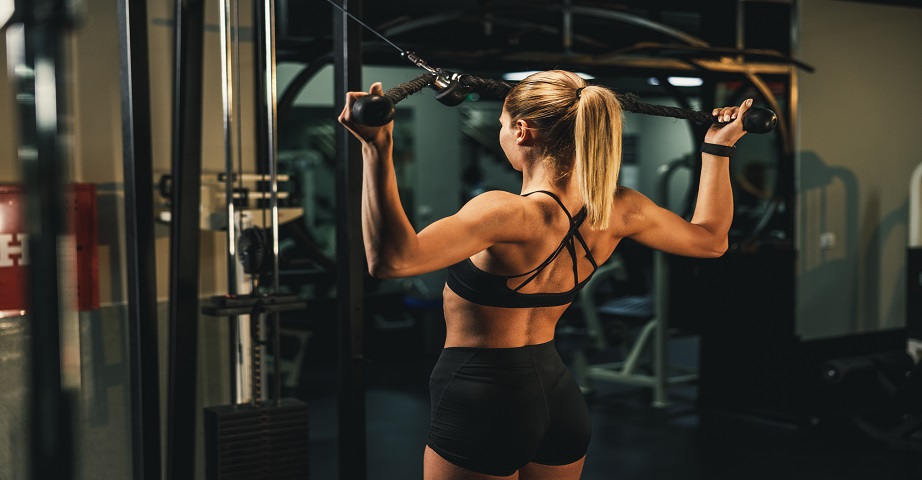Latissimus dorsi - the best exercises for the latissimus dorsi muscle

Back musles are the second largest muscle part in the human body, and the largest surface of all back muscles is the latissimus dorsi muscle. It is a structure that visually expands the upper body, creating a "V" figure desired among many men training at the gym. However, the latissimus dorsi muscle is also willingly strengthened by women, which promotes the achievement of an hourglass-shaped figure. What are the functions of the latissimus dorsi muscle, and what exercises are worth doing to strengthen it?
Summary
Latissimus dorsi muscle - anatomy
The latissimus dorsi muscle, from the latin muscle of latissimus dorsi, is a broad, thin and flat muscle that covers the lower back area and partly also the lateral part of the chest. It is a superficial muscle that can usually be felt under the skin without any problems.
The latissimus dorsi passes through both the lumbar, thoracolateral and axillary parts of the human body. At the same time, it covers the posterior inferior serratus muscle, intercostal muscles, as well as the ribs. Moreover, the latissimus dorsi reaches the lower angle of the scapula and thus attaches it to the chest.
Of all the muscles, the latissimus dorsi has the largest surface area. Thus, its initial muscle attachment can be divided into four parts, namely: the vertebral, hip, shoulder blades and rib part. The structure begins with the spinous processes of the six lower thoracic vertebrae, the five lumbar vertebrae, as well as the medial cruciate crest. In addition, the initial muscle attachments are located on the back third part of the outer iliac crest, in the lower angle of the shoulder blade near the attachment of the major oblique muscle and on the outer surface of the ninth or tenth, and also the eleventh and twelfth ribs. The final muscle attachment can be found on the crest of the smaller nodule of the humerus from the front and medial sides.
What is it responsible for and what functions does the latissimus dorsi muscle perform?
The latissimus dorsi muscle performs important functions in the human system. Its primary task is:
- arm adduction,
- straightening arm,
- internal rotation of the arm.
Moreover, the latissimus dorsi is the muscle supporting respiratory functions - it is helpful during inhalation, where it lifts the lower ribs, as well as during exhalation, tightening the body. The latissimus dorsi is also called the cough muscle because it participates in this reaction.
How to activate the latissimus dorsi muscle?
To activate the latissimus dorsi muscle, it is worth taking care of the initial fatigue, that is, firstly, focus on performing an isolated exercise for this muscle part, which will allow the maximum warming up of the trained body part and positively affect performance.
Activation of the latissimus dorsi should start already during the warm-up, taking into account in its course mobilization exercises. Dynamic stretching or rolling of the back may also be helpful in relaxing these muscles and improving their mobility. In addition, focusing on the latissimus dorsi muscle, it is worth paying attention to the trapezius muscle, because both structures are related to each other during anatomical movements and during multi-joint exercises.
How to exercise the latissimus dorsi muscle?
Back training among beginners should start with the development of all back muscles, not just the latissimus dorsi muscle. Therefore, when starting your adventure with the gym and physical activity, it is recommended to perform 4-5 exercises focused around the back muscles in 3 series of 8-12 repetitions.
Advanced and experienced athletes should focus on exercising individual back muscles, such as the latissimus dorsi, individually adjusting the training volume, intensity and load. Then you can do 4-6 exercises in 3-4 series of 6-15 repetitions. It is also worth using training combined with the chest, which is an antagonistic muscle group for the back.
Exercises on the latissimus dorsi muscle
Examples of exercises for the latissimus dorsi muscle, which should be taken into account when creating a training plan, are:
- Paddling with lower lift handle for hip,
- Pulling the upper lift handle to the side with a neutral grip,
- Pulling the rod with supinated grip to the width of the shoulders to the rib cage,
- "Ski jumper",
- Paddling with a dumbbell,
- Pulling down the upper lift bar, standing with straightened hands.

5 best exercises for the latissimus dorsi muscle
The size of the latissimus dorsi muscle makes that many exercises involving this muscle part are available. You can do multi-joint exercises, as well as isolated exercises, focusing around the individual part of the latissimus dorsi.
What exercises are best done for the latissimus dorsi muscle?
- Pull up on the bar - this is a multi-joint exercise that mobilizes not only the latissimus dorsi muscle, but also other back muscles, as well as biceps and stabilizing muscles. When performing the exercise, you need to grab the bar with pronated grip to a width slightly larger than the shoulder spacing. Then you need to tense the shoulder blades and make a dynamic pull-up movement, so that the chin of the player is in the area of the bar. Next, you should focus on performing the eccentric phase to full shoulder extension.
- Paddling with a barbell in the fall of the torso - this is an exercise that involves the latissimus dorsi muscle, as well as other back muscles. This is an activity that can be performed with the pronated grip or the supinated grip. By deciding on the pronated grip, you can also mobilize the chest and biceps. During the exercise, you should stand in a small straddle and gently bend the knee joints. Hold the barbell with the closed grip much wider than the shoulder spacing, and then take a position in the torso fall. Next, along with the exhalation, you should be made a dynamic concentric movement, focusing on attracting the bar to the chest. Later, along with the inhalation, you need to make an eccentric movement, lowering the barbell to the starting position.
- Pulling down the upper lift handle with one hand - this is a unilateral exercise, which involves catching and pulling the lift handle with one hand. You should sit sideways to the lift and grab the rope of the lift with the arm located on the outside. Then, along with the exhalation, pull the rope to the shoulder line. During the maximum back tension, you can take a short break to return to the starting position.
- Negative pull-ups - this is an exercise that focuses only on leaving the body to maximize their elongation. Therefore, you should prepare for the activity as for standard pull-up, but instead of pulling, you should jump up or use equipment, such as a bench, and then focus on slowly lowering the whole body.
- Pulling the upper lift bar to the hips - this is an exercise that mobilizes not only the latissimus dorsi muscle, but also the infraspinatus muscle or the back part of the deltoid muscle. To properly perform the exercise, you need to stand in front of the lift and take a stable position. Then you need to grab the bar with the pronated grip to the width of the shoulder spacing and gently bend the elbow and knee joints. Next, it is worth leaning slightly forward and make a dynamic concentric movement, during which the bar will be pulled to the hips, while maintaining the bent knee joints. During this time, exhalation should also be done. Later, you need to focus on a calm eccentric movement, moving the bar over your head and stretching the muscles. At the same time, inhale must be done.
Stretching the latissimus dorsi
Stretching the latissimus dorsi muscle is an important part of back training. However, not only athletes should use stretching the latissimus dorsi - sedentary people should also include this type of activity in their lives to reduce back pain and the discomfort associated with it.
Stretching the latissimus dorsi muscle can help stabilize the spine and reduce back pain. In addition, it can relax muscle fibres, and thus help the regeneration of the body. Indirectly stretching the latissimus dorsi can also help increase muscle strength.
What exercises are worth doing as part of stretching the latissimus dorsi muscle? For example, such as:
- Cat's back - should take on all fours position, and hands and knees should be placed shoulder wide. Then the spine should be bent down, and the head drawn up and remain in this position for about 20 seconds;
- Cobra position - lie on your back and then uplift your torso off the ground, supporting yourself with your hands. Stay in this position for about 20 seconds and return to the starting position;
- Child's position - it is necessary to kneel, and then sit on the heels. Extend your knees and move your entire body forward until you lower your torso to the ground. Hands should be extended forward. You should stay in the position for about 30 seconds and then you can return to the starting position.
Our bestsellers
Bibliography:
- Bochenek A., Reicher M., Human anatomy, Part I, Medical Publishing House PZWL
- https://onlinelibrary.wiley.com/doi/full/10.1111/joa.12903
- https://pubmed.ncbi.nlm.nih.gov/30411350/

